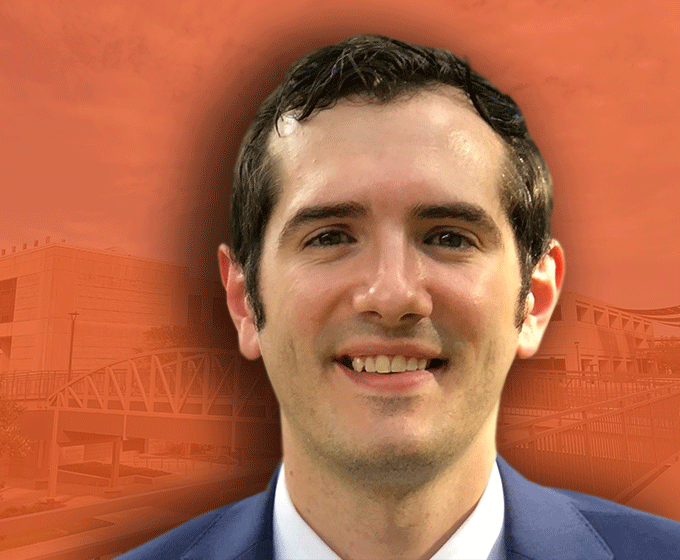
NOVEMBER 30, 2021 — Editor’s note: This op-ed by Chris Combs, the Dee Howard endowed assistant professor and aerospace program coordinator in the UTSA Department of Mechanical Engineering, originally appeared in the San Antonio Express-News.
The sky isn’t falling … yet. We all have plenty to worry about—from COVID-19 to climate change to holiday shopping, and even the fates and fortunes of our chosen football team (Birds up!)—so you don’t need me adding something to your list.
Still, here’s some bad news: You should be worried about space, too. It’s easy to forget space is a mere 60 miles over our heads, with the International Space Station flying by at 17,500 miles per hour about 250 miles up. We take for granted how much we’ve come to depend on the global space infrastructure of satellites that provide GPS, weather forecasts and instant global communication.
It’s time to start paying attention to what’s happening in space.
China recently tested a “fractional orbital bombardment system,” which is a fancy way of saying it flew a nuclear-capable hypersonic missile around the globe before hitting a target in China. The Chinese could use a system like this to strike targets in the U.S. with virtually no warning, and at the moment, there’s not much we could do to stop it. U.S. missile defense capabilities are also insufficient to stop a large volley of ballistic missiles from an equipped and determined adversary.
Russia demonstrated an anti-satellite weapon test in which a land-based missile was fired at a retired Soviet satellite in low-Earth orbit. This prompted the International Space Station crew, including a Russian commander, to temporarily take refuge in the Dragon and Soyuz modules given that even pea-size space debris at orbital velocities can rip through metal like superpowered mortar rounds.
The senseless test generated thousands of pieces of space debris that will remain in orbit for several years. We have entered an age in which continued careless behavior in space could cripple our modern orbital infrastructure. Recent estimates suggest there are greater than 100 million pieces of human-created debris in Earth’s orbit. It’s not crazy to imagine orbital space as an impassable minefield of derelict satellites and other junk caused by our own malfeasance and neglect.
We also have asteroids to worry about. While scientists believe they have cataloged almost all of the largest “planet-killer” asteroids in our vicinity, there are an estimated 20,000 “medium-sized” asteroids capable of leveling a city, of which we have identified less than half. As part of its Planetary Defense directive, NASA is launching the Double Asteroid Redirection Test, or DART, mission to test a means to redirect an Earth-bound asteroid. We just need to detect them first, and unfortunately, many recent asteroids were not detected until after they whizzed by or, in the case of the 2013 Chelyabinsk meteor, until impact.
These problems need attention now. I imagine the best solutions will involve a mix of diplomacy, international cooperation and technological advances.
We’re doing what we can here at the University of Texas at San Antonio, for example, with a growing aerospace engineering program and the completion of a new hypersonic wind tunnel. Fostering a diverse and technically trained workforce is a good place to start.
But as a country we need to do more. So go outside tonight, look up at the stars and enjoy space. If you time it right, you might see the space station fly by. Because, at least for today, the sky isn’t falling. Let’s try to keep it that way.
UTSA Today is produced by University Communications and Marketing, the official news source of The University of Texas at San Antonio. Send your feedback to news@utsa.edu. Keep up-to-date on UTSA news by visiting UTSA Today. Connect with UTSA online at Facebook, Twitter, Youtube and Instagram.
Move In To COLFA is strongly recommended for new students in COLFA. It gives you the chance to learn about the Student Success Center, campus resources and meet new friends!
Academic Classroom: Lecture Hall (MH 2.01.10,) McKinney Humanities BldgWe invite you to join us for Birds Up! Downtown, an exciting welcome back event designed to connect students with the different departments at the Downtown Campus. Students will have the opportunity to learn about some of the departments on campus, gain access to different resources, and collect some giveaways!
Bill Miller PlazaJoin us for an intimate evening of cocktails, conversation, and culinary inspiration with Pati Jinich, Emmy-nominated chef and James Beard Award-winning author. Enjoy light bites and signature drinks in the warm, modern setting of Mezquite as Pati connects with guests over her passion for Mexican cuisine and storytelling.
Mezquite Restaurant in Pullman Market, 221 Newell Ave., San Antonio 78215From inspired courses to thoughtful pairings and a rich sense of community, the Ven a Comer Signature Dinner is a night of shared meals, shared stories, and unforgettable flavor.
Stable Hall (Pear Brewery), 307 Pearl Pkwy, San Antonio 78215Come and celebrate this year's homecoming at the Downtown Campus with food, games, giveaways, music, and more. We look forward to seeing your Roadrunner Spirit!
Bill Miller PlazaThe University of Texas at San Antonio is dedicated to the advancement of knowledge through research and discovery, teaching and learning, community engagement and public service. As an institution of access and excellence, UTSA embraces multicultural traditions and serves as a center for intellectual and creative resources as well as a catalyst for socioeconomic development and the commercialization of intellectual property - for Texas, the nation and the world.
To be a premier public research university, providing access to educational excellence and preparing citizen leaders for the global environment.
We encourage an environment of dialogue and discovery, where integrity, excellence, respect, collaboration and innovation are fostered.